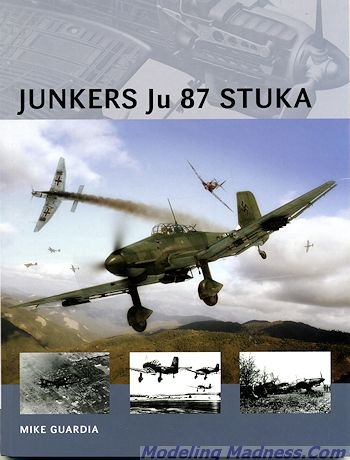 Without
a doubt, the most recognizable weapon of the early war was the Ju-87 Stuka. In
books and magazines about the period, you will inevitably find a much published
image of a Stuka in a dive and dropping its bombs. Against specific targets, a
dive bomber was the most accurate way of delivering bombs, and no one did it
better in the west than the Germans.
Without
a doubt, the most recognizable weapon of the early war was the Ju-87 Stuka. In
books and magazines about the period, you will inevitably find a much published
image of a Stuka in a dive and dropping its bombs. Against specific targets, a
dive bomber was the most accurate way of delivering bombs, and no one did it
better in the west than the Germans.
The Ju-87s development was spurred by Ernst Udet, who was enamored with
dive bombing after seeing demonstrations of a Curtiss Hawk doing such maneuvers
in the US during a visit in the early 1930. A competition was held in Germany
for a dive bomber and it was Junkers that provided the winning design. After
changing the tail section, the Stuka as we know it was pretty well done. Unlike
the dive bombers of other nations, the Stuka was designed to do vertical dives.
This not only improved the accuracy of the bombing, but also provided some
technical challenges. One was how to keep the pilot from blacking out during the
huge G force that was placed on his body during recovery from the dive.
This challenge was met, not by aviation medicine, but by engineering.
The Stuka was, to my knowledge, unique in that there was an automatic recovery
system built into the aircraft. The pull out altitude was set and the pilot
simply pressed a button before going into the dive. When a certain altitude was
reached, the aircraft would automatically pull out of the dive. Often the crew
would black out, but thanks to this feature, the plane remained in control until
the pilot recovered and switched off the system.
Early Ju-87s were tested in Spain during the Spanish Civil War and it
was discovered that the plane was underpowered. The aircraft could carry the
designated bomb load, but only if the radio operator/gunner was left on the
ground. Despite this and due to a lack of any real air opposition, the Stuka
proved to be most successful. The later Ju-87B improved the power to the level
that full crew and bomb load could be carried and it is this version that saw
the opening of WWII in Europe.
During the initial year of the war, where the Germans were able to
maintain air superiority, the Ju-87 was an extremely effective weapon. However,
once it ran into determined air defense over the UK, the tables quickly turned
and the Stuka's poor maneuverability and slow speed resulted in heavy losses. It
was quickly removed from combat. Lesson learned was that when the Germans had
air superiority, even only locally, the plane was quite effective and so it was
used in other areas of the war from North Africa and the Mediterranean to the
war against the Soviet Union. As there was no real replacement, it was further
improved, but still was slow.
It became even slower when turned into a tank killer by the
addition of underwing 37mm cannon, but again, it was highly effective in this
new task. The highest decorated German soldier of WWII was Hans Rudel, a Stuka
pilot. The aircraft was also exported to some Axis nations.
In this book, the author looks into the background and the development
of the Ju-87 as well as the aircraft that came before it.
All of the different variants are covered as well as an in-depth look at the
aircraft and its systems. Several pages of full color art work, and profiles are included as well as the
usual bevy of period photographs and the large cutaway on the back two pages. A great read and highly recommended.
August 2014
For more on the complete line of Osprey books,
visit www.ospreypublishing.com. In the US, it is
Osprey Direct at 44-02 23rd St, Suite 219, Long Island City, NY 11101., where you can
get a catalogue of available books.
If you would like your product reviewed fairly and
fairly quickly, please
contact
the editor or see other details in the
Note to
Contributors.
 Without
a doubt, the most recognizable weapon of the early war was the Ju-87 Stuka. In
books and magazines about the period, you will inevitably find a much published
image of a Stuka in a dive and dropping its bombs. Against specific targets, a
dive bomber was the most accurate way of delivering bombs, and no one did it
better in the west than the Germans.
Without
a doubt, the most recognizable weapon of the early war was the Ju-87 Stuka. In
books and magazines about the period, you will inevitably find a much published
image of a Stuka in a dive and dropping its bombs. Against specific targets, a
dive bomber was the most accurate way of delivering bombs, and no one did it
better in the west than the Germans.